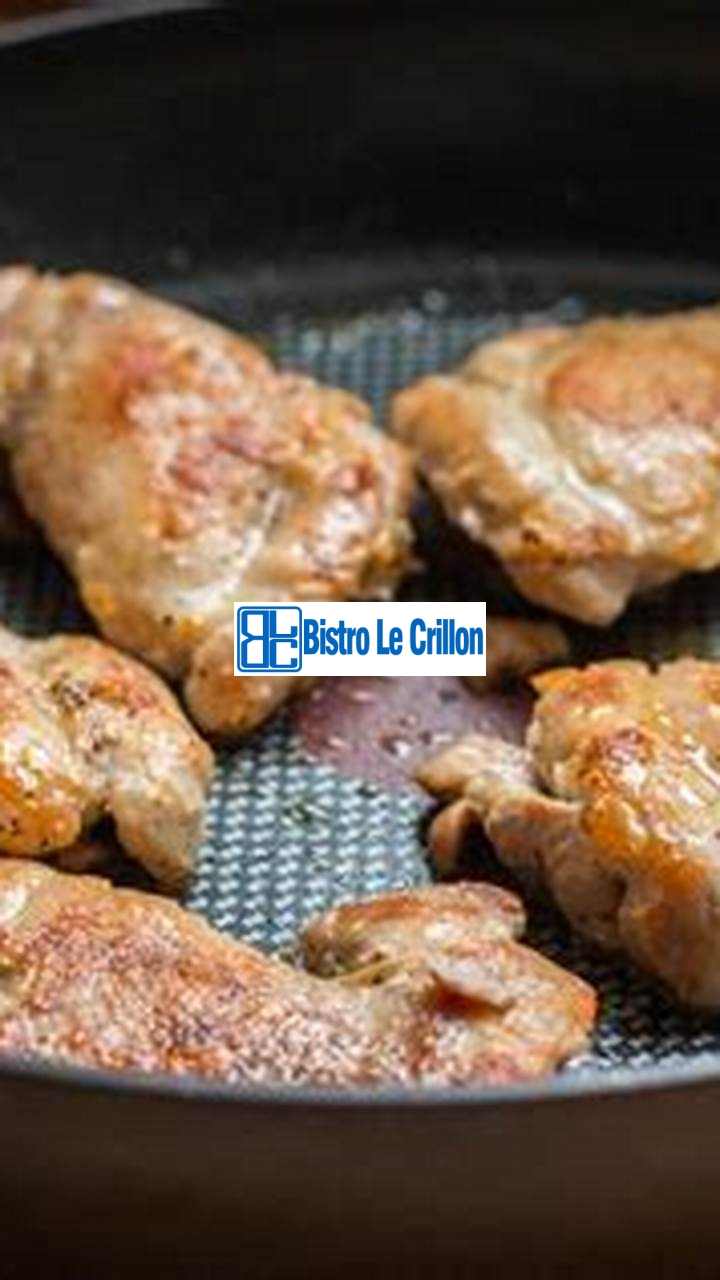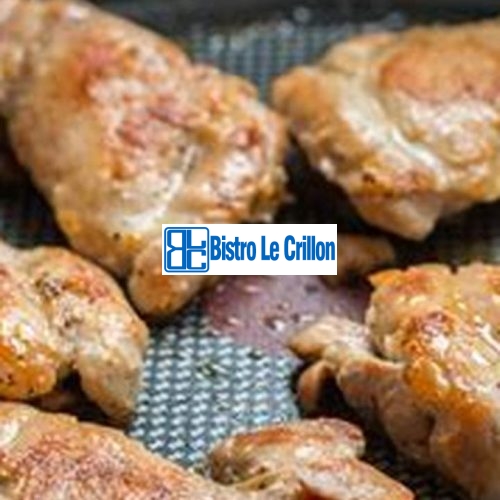Are you ready to become a master at pan cooking chicken? In this article, we will guide you through the art of cooking tender and juicy chicken in a pan. Whether you’re a beginner or an experienced cook, our step-by-step instructions will help you achieve culinary success. From selecting the right cut of chicken to mastering the perfect sear, you’ll learn valuable techniques that will elevate your chicken dishes to a whole new level. So grab your apron and let’s get started on this flavorful journey! ️

Understanding Pan Cooking
Pan cooking is a versatile cooking method that involves using a pan to cook chicken. It is a popular technique that can be used to create a variety of delicious chicken dishes. Whether you prefer a crispy skin or a tender and juicy interior, pan cooking allows you to achieve the perfect results every time.
The process of pan cooking involves heating oil or butter in a pan and then adding the chicken to cook. The chicken is typically seasoned with herbs and spices to enhance its flavor. As the chicken cooks, it releases its natural juices, resulting in a delicious sauce that can be used to coat the chicken.
One of the advantages of pan cooking chicken is that it allows for precise control over the cooking process. You can easily adjust the heat and cooking time to achieve the desired level of doneness. This makes it a great option for beginners and experienced cooks alike.
Additionally, pan cooking allows for quick and efficient cooking. Unlike other cooking methods that require preheating an oven or waiting for water to boil, pan cooking chicken can be done in a matter of minutes. This makes it a perfect choice for busy weeknights when you want to prepare a delicious meal in a short amount of time.
What is Pan Cooking
Pan cooking is a cooking method that involves using a pan to cook chicken. It is a versatile technique that can be used to create a wide variety of chicken dishes. Whether you prefer a classic fried chicken or a flavorful stir-fry, pan cooking allows you to achieve the desired results.
When pan cooking chicken, it is important to choose the right pan. A heavy-bottomed pan, such as a cast iron skillet or stainless steel pan, is ideal for pan cooking. These pans distribute heat evenly and retain heat well, ensuring that the chicken cooks evenly.
In addition to the pan, it is also important to season the chicken properly. This can be done by rubbing the chicken with a mixture of herbs and spices. This not only adds flavor to the chicken, but also helps to tenderize it.
The Benefits of Pan Cooking
Pan cooking chicken offers several advantages compared to other cooking methods. One of the main benefits is the ability to control the cooking process. With pan cooking, you have the ability to adjust the heat and cooking time to achieve the desired level of doneness.
Pan cooking also allows for quick and efficient cooking. It eliminates the need for preheating an oven or waiting for water to boil, making it a time-saving option for busy individuals. Additionally, pan cooking creates a delicious sauce from the natural juices of the chicken, adding an extra layer of flavor to the dish.
Furthermore, pan cooking is a versatile cooking method that can be used to create a variety of chicken dishes. From crispy fried chicken to tender grilled chicken, the possibilities are endless. With pan cooking, you can explore different flavors and cooking techniques to create unique and delicious meals.
Choosing the Right Pan
When it comes to pan cooking chicken, choosing the right pan is essential. A heavy-bottomed pan, such as a cast iron skillet or stainless steel pan, is recommended for pan cooking. These pans distribute heat evenly and retain heat well, ensuring that the chicken cooks evenly.
It is also important to consider the size of the pan. The pan should be large enough to comfortably fit the chicken without overcrowding. Overcrowding the pan can result in uneven cooking and prevent the chicken from achieving a crispy exterior.
Additionally, the type of pan material can also affect the cooking process. Non-stick pans are convenient for easy cleanup, but they may not provide the same level of browning and flavor as a traditional pan. Consider the desired cooking outcome and choose a pan that aligns with your preferences.
In conclusion, pan cooking is a versatile and efficient cooking method for preparing delicious chicken dishes. Understanding the basics of pan cooking, such as choosing the right pan and seasoning the chicken properly, is key to mastering this art. With practice and experimentation, you can become a pro at pan cooking chicken and impress your family and friends with your culinary skills.
Preparing the Chicken
When it comes to pan cooking chicken, proper preparation is key. By taking the time to prepare the chicken correctly, you can ensure that it cooks evenly and turns out delicious every time. Here are the essential steps to follow:
Choosing the Right Cut of Chicken
The first step in preparing chicken for pan cooking is selecting the right cut. Different cuts of chicken have different cooking times and textures, so it’s important to choose wisely. For pan cooking, boneless, skinless chicken breasts or chicken thighs are ideal. These cuts cook relatively quickly and are versatile in terms of flavor and seasoning.
Pro Tip: To save time, you can buy pre-cut boneless, skinless chicken breasts or thighs from your local grocery store. This eliminates the need for any additional prep work.
Marinating for Flavor
Marinating the chicken is an excellent way to add flavor and tenderness. It involves soaking the chicken in a mixture of herbs, spices, oils, and acids for a specific period. The marinade infuses the chicken with delicious flavors while also helping to tenderize the meat.
When marinating chicken for pan cooking, keep the following steps in mind:
- Choose a marinade: There are countless marinade recipes available, ranging from simple options like lemon and garlic to more complex blends with various herbs and spices. Select one that suits your taste preferences and complements the dish you plan to prepare.
- Prepare the marinade: In a bowl, whisk together the marinade ingredients until well combined. You can customize the flavors based on your preferences. For example, if you enjoy spicy food, add some chili flakes or hot sauce to the marinade.
- Coat the chicken: Place the chicken in a resealable plastic bag or a shallow glass dish and pour the marinade over it. Ensure that each piece of chicken is coated evenly. Seal the bag or cover the dish with plastic wrap, then refrigerate for at least 30 minutes or up to 24 hours. The longer the chicken marinates, the more intense the flavor will be.
Pro Tip: To further enhance the flavor, you can prick the chicken with a fork before marinating. This allows the marinade to penetrate deeper into the meat.
Brining for Juiciness
Brining is another technique that guarantees juicy and flavorful chicken. It involves soaking the chicken in a saltwater solution, which helps to retain moisture during the cooking process.
Follow these steps to brine chicken before pan cooking:
- Prepare the brine: In a large pot, combine water, salt, and any other desired seasonings like herbs and spices. Stir until the salt has dissolved completely.
- Add the chicken: Place the chicken pieces in the brine, ensuring that they are fully submerged. If needed, use a weighted plate or object to keep the chicken immersed.
- Brine the chicken: Cover the pot and refrigerate for at least 2 hours or up to 8 hours. The brining time depends on the size and thickness of the chicken pieces. Larger cuts may require a longer brining period.
- Rinse and pat dry: After brining, remove the chicken from the brine and rinse it thoroughly under cold water. Pat the chicken dry with paper towels before proceeding with the pan cooking process.
Pro Tip: If you prefer, you can add additional flavors to the brine, such as garlic, onion, or citrus slices, to infuse the chicken with extra taste.
By properly preparing the chicken, whether it’s choosing the right cut, marinating for flavor, or brining for juiciness, you’ll master the art of pan cooking chicken and impress your friends and family with delicious meals every time. Happy cooking!
Mastering the Pan Cooking Technique
Mastering the art of pan cooking chicken is an essential skill for any home cook. With the right techniques and tips, you can achieve perfectly cooked chicken with a delicious crust. Whether you prefer boneless skinless chicken breasts or bone-in thighs, pan cooking allows you to achieve a flavorful and juicy result. Follow these expert tips and techniques to become a master of pan cooking chicken.
Seasoning and Preheating the Pan
The first step in pan cooking chicken is to properly season the meat. Seasoning adds flavor and enhances the taste of the chicken. You can use a combination of salt, pepper, and spices according to your preference. To ensure even seasoning, rub the spices onto both sides of the chicken and let it sit for a few minutes before cooking. This allows the flavors to penetrate the meat.
Preheating the pan is crucial to achieve a perfect crust. Heat a cast iron or stainless steel pan over medium-high heat for a few minutes until it becomes hot. Avoid using non-stick pans for pan cooking chicken as they may not provide the desired crust.
Searing for a Perfect Crust
Searing the chicken creates a beautiful crust that locks in the juices and flavor. To achieve a perfect sear, follow these steps:
- Pat the chicken dry with a paper towel to remove excess moisture. This helps in achieving a crisp crust.
- Add a small amount of oil or butter to the preheated pan and swirl it around to coat the surface.
- Place the chicken skin-side down in the pan. Allow it to cook undisturbed for a few minutes until the skin becomes golden brown and crispy.
- Carefully flip the chicken using tongs or a spatula. Cook the other side until it develops a golden crust.
By following these steps, you can achieve a perfectly seared chicken with a delicious crust that adds texture and flavor to the dish.
Flipping and Temperature Control
Flipping the chicken at the right time is crucial to ensure even cooking. When you notice that the chicken is almost halfway cooked, it’s time to flip it. Use tongs or a spatula to gently turn the chicken over. This helps in cooking both sides evenly and prevents the chicken from drying out.
Temperature control is important to ensure that the chicken is cooked thoroughly without drying it out. Use a meat thermometer to check the internal temperature of the chicken. The safe temperature for cooked chicken is 165°F (74°C). Remove the chicken from the pan once it reaches the desired temperature and let it rest for a few minutes before serving.
Following these techniques and tips will help you master the art of pan cooking chicken. Remember to season the chicken, preheat the pan, sear for a perfect crust, and control the flipping and temperature. With practice, you’ll be able to cook delicious and flavorful chicken every time.
Variations and Seasoning Ideas
When it comes to pan cooking chicken, the possibilities are endless. By exploring different flavors and seasonings, you can elevate your dishes and create a culinary masterpiece. Whether you prefer herb-infused chicken, spicy Cajun flavors, or Asian-inspired teriyaki, there is always something new to try. Let’s dive into each variation and discover the secrets behind creating flavorful pan-cooked chicken dishes.
Herb and Citrus Infused Chicken
When you want to add a burst of freshness to your chicken, herb and citrus infusions are the way to go. Start by marinating your chicken with a combination of your favorite herbs such as rosemary, thyme, and parsley. The bright flavors of citrus fruits like lemon or orange will complement the herbs perfectly.
Once your chicken is infused with the flavors, heat your pan with a drizzle of olive oil. Place the chicken in the pan and cook it until it reaches an internal temperature of 165°F. The herb and citrus infusion will create a tantalizing aroma that will have your taste buds watering in anticipation.
Spicy Cajun Chicken
For those who love a kick of heat, spicy Cajun chicken is the perfect choice. Create your own Cajun spice blend using a combination of paprika, cayenne pepper, garlic powder, and onion powder. Rub the spice blend onto your chicken, ensuring that it is well coated.
Heat your pan over medium-high heat and add a tablespoon of oil. Once the oil is hot, place the Cajun-spiced chicken in the pan and cook it until it is browned on both sides and fully cooked. The Cajun spices will add a fiery flavor to the chicken, leaving your taste buds dancing with delight.
Asian-inspired Teriyaki Chicken
If you’re in the mood for some Asian-inspired flavors, teriyaki chicken is a great option. To make a delicious teriyaki sauce, combine soy sauce, honey, ginger, and garlic in a bowl. Marinate your chicken in the sauce for at least 30 minutes to allow the flavors to penetrate the meat.
Heat your pan and add a drizzle of oil. Once the oil is hot, cook the marinated chicken until it is browned and cooked through. The teriyaki sauce will caramelize and create a sticky glaze on the chicken, resulting in a sweet and savory flavor combination that will make your taste buds sing.
In conclusion, exploring different variations and seasonings is key to mastering the art of pan cooking chicken. Whether you choose to infuse your chicken with herbs and citrus, spice it up Cajun-style, or go for Asian-inspired teriyaki, each variation offers a unique and delicious flavor profile. So, get creative in the kitchen and let your taste buds be your guide. Happy cooking! ️
Troubleshooting and Common Mistakes
When it comes to pan cooking chicken, there are a few common challenges that may arise during the process. However, with the right techniques and a little bit of practice, you can easily overcome these challenges and master the art of pan cooking chicken.
Overcooking and Dry Chicken
One of the most common mistakes when pan cooking chicken is overcooking it, leading to dry and rubbery meat. To avoid this, it’s important to keep a close eye on the cooking time and temperature. Use a meat thermometer to check the internal temperature of the chicken to ensure it reaches a safe minimum temperature of 165°F (74°C).
Another helpful tip to prevent overcooking is to pound the chicken breast to an even thickness before cooking. This will ensure that the chicken cooks more evenly and reduces the risk of overcooking.
An important factor in avoiding dry chicken is to properly marinate the chicken before cooking. Marinating the chicken in a flavorful mixture of herbs, spices, and oils will help to lock in moisture and enhance the overall taste.
Important point: Proper monitoring of cooking time and using a meat thermometer will prevent overcooking and dry chicken.
Unevenly Cooked Chicken
Unevenly cooked chicken can be another common challenge when pan cooking. The key to addressing this issue is to ensure that the chicken is placed in the pan evenly and cooked at the right temperature.
Start by preheating the pan over medium-high heat before adding the chicken. This will help to ensure that the chicken cooks evenly throughout. Additionally, avoid overcrowding the pan, as this can result in uneven cooking. Cook the chicken in batches if necessary.
If you’re still having trouble with uneven cooking, you can try using a meat tenderizer to flatten the chicken breasts to an even thickness. This will help the chicken cook more evenly and reduce the chances of having some parts undercooked while others are overcooked.
Important point: Preheating the pan and cooking the chicken in batches will help to achieve evenly cooked chicken.
Burning and Sticking to the Pan
Another challenge that you may encounter when pan cooking chicken is the chicken sticking to the pan and potentially burning. To avoid this, it’s essential to properly prepare the pan and use the right cooking oil.
Start by selecting a pan with a non-stick surface or using a cast-iron skillet. Before adding the chicken, make sure the pan is preheated properly. This will help to create a barrier between the chicken and the pan, preventing sticking.
When choosing a cooking oil, opt for ones with a high smoke point such as canola oil or vegetable oil. These oils can withstand high heat without burning, reducing the chances of the chicken sticking to the pan.
Important point: Using a non-stick pan, preheating it properly, and selecting the right cooking oil will prevent the chicken from sticking and burning.
By identifying and addressing these common challenges, you’ll be well on your way to mastering the art of pan cooking chicken. With practice and a little experimentation, you’ll be able to cook tender, juicy chicken every time you step into the kitchen.
Thank you for reading our article on how to pan cook chicken! We hope you found the step-by-step instructions helpful and that you’re feeling more confident in your cooking skills. If you enjoyed this article, be sure to bookmark our website and visit again later for more delicious recipes and cooking tips. Happy cooking!
Frequently Asked Questions
Here are some common questions about pan cooking chicken:
| No. | Questions | Answers |
|---|---|---|
| 1. | How do I know if the chicken is cooked through? | The best way to ensure the chicken is cooked through is to use a meat thermometer. The internal temperature should reach 165°F (74°C) for fully cooked chicken. |
| 2. | Can I marinate the chicken before pan cooking? | Absolutely! Marinating the chicken before cooking can add flavor and juiciness. Just make sure to discard any leftover marinade after use. |
| 3. | Should I season the chicken before or after cooking? | It’s best to season the chicken before cooking to allow the flavors to penetrate the meat. However, you can also season it after cooking if you prefer. |
| 4. | Can I use a non-stick pan for pan cooking chicken? | Yes, a non-stick pan can make it easier to cook chicken without it sticking to the bottom. Just be careful not to use metal utensils that can scratch the non-stick surface. |
| 5. | How long should I let the chicken rest before serving? | It’s recommended to let the chicken rest for about 5 minutes before serving. This allows the juices to redistribute, resulting in juicier meat. |
| 6. | Can I use boneless chicken breasts for pan cooking? | Yes, boneless chicken breasts work well for pan cooking. Just adjust the cooking time accordingly to ensure they are fully cooked. |
Closing Thoughts
We hope this article has inspired you to try pan cooking chicken at home. With a few simple steps and some flavorful ingredients, you can create a delicious and wholesome meal. Remember to experiment with different seasonings and sauces to add your own personal touch. Don’t forget to visit our website again for more tasty recipes and cooking guides. Happy cooking and bon appétit!

Pan Cooked Chicken
Ingredients
- 4 boneless skinless chicken breasts
- 2 tablespoons olive oil
- 1 teaspoon salt
- ½ teaspoon black pepper
- 1 teaspoon garlic powder
- 1 teaspoon paprika
Instructions
- Heat a large skillet over medium-high heat. Add the olive oil and let it heat up.
- Season the chicken breasts with salt, pepper, garlic powder, and paprika on both sides.
- Place the seasoned chicken breasts in the hot skillet. Cook for about 6-7 minutes on each side, or until the internal temperature reaches 165°F (74°C).
- Remove the chicken from the skillet and let it rest for about 5 minutes before serving.
- Slice the chicken and serve it with your favorite sides. Enjoy!






